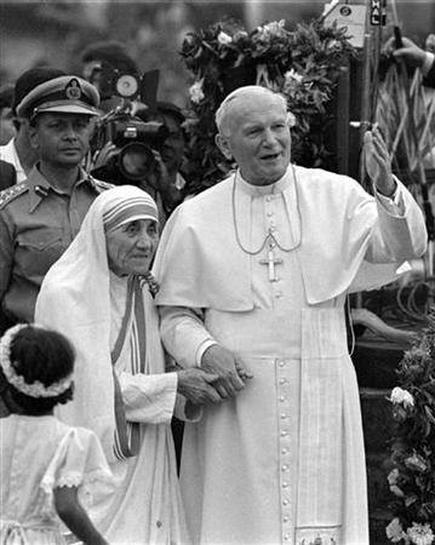The New York Times recently published an opinion piece entitled “Was Mother Teresa a Cult Leader?” It branded the Missionaries of Charity (MC) as cultic and St. Mother Teresa as more of a cult leader than a saint of the Catholic Church. What evidence is that article based on? A new podcast, The Turning: The Sisters Who Left, released in May 2021, which features interviews from sisters who have left the MC and tell, or better, “recycle” their stories (many of these stories have been published before). Re-marketing these old, debunked accusations gives audiences a new way to be misled by old information, and “cancel culture” threatens to destroy the reputation of one of the most beloved women of the twentieth century.
The attack on Mother Teresa as a cult leader raises a fundamental question: How can cults be defined? Former MC member Mary Johnson admits in the podcast interview that “one doesn’t always know where to draw the line between religion and cult,” although she consistently draws the line on the cult side, when she’s describing the Missionaries of Charity. Scholars don’t agree on the definition of cult and the derived cultic practices. Several social science scholars suggest avoiding using the word altogether in academic literature and find the media use of the term highly problematic.
Secular experts rely on sociological and psychological-behavioral factors in seeking to define “cults.” Merriam-Webster’s definition of cult might be helpful here:
a small religious group that is not part of a larger and more accepted religion and that has beliefs regarded by many people as extreme or dangerous; a situation in which people admire and care about something or someone very much or too much; a religion regarded as unorthodox or spurious; a small group of very devoted supporters or fans.
Clearly, this definition of cult does not apply to the MC, one of the most vibrant religious orders in the Catholic Church, with millennia-old beliefs and theology behind it. The MC do not practice a distorted form of Christianity or adhere to doctrines that go against Christian orthodoxy. Instead, the order and the Constitutions of MC were approved by the Congregation for the Evangelization of People – Propaganda Fide – and are in conformity with the directives of the Second Vatican Council.
What are the cultic allegations against the MC presented by the sisters who left? Episode one of the podcast is titled “No Turning Back.” The title is eye-catching and cultic in its own right. Yes, cults seduce, abuse, and have caused mass suicides. And members of such groups who have impulsively rushed to join have a hard time escaping.

The New York Times column cites Mary Johnson who claimed that she hoped to escape the “cult” but was caught in the act: “So, I wouldn’t have been able to go, you know, more than five or six paces before somebody ran up to me and said, ‘Where are you going?’”
This is simply not true. To become a sister of Charity, according to the Constitutions, takes a long period of discernment: six months of Aspirancy; one year of Postulancy; two years of Novitiate; five years of Juniorate; and one year of Tertianship, which is, according to the constitutions, a special period of spiritual renewal preceding the final profession.
During the years of Juniorate the vows are renewed annually. At any time if the sister does not renew the vows, she can leave. The Constitutions also prescribe rules for dismissal. So, if Johnson at any time during her training (before the vows) wanted to leave she would have done so and not had to endure being inside the order for twenty years, as she claims she was forced to do. Indeed, there was plenty of time and ample opportunity for Johnson to turn back.
Johnson also reports that Mother Teresa sat at the aspirants’ table to talk to the women, saying: “God has called you. You must be faithful for life or pack up and go home right now.”
Precisely. Mother Teresa was talking of a life-long-vocation; she was not tricking or flattering the aspirants in order to persuade them to stay if they did not have the vocation. Additionally, the order also pays the expenses of a dismissed sister. Real cults do not follow directives like this one: “Who has no or insufficient means of support, the Society must in charity give her what is necessary to return home in a safe and becoming manner.”
Another former MC Sister, Colette Livermore, comments in the podcast how isolated the sisters were from “anyone else,” getting input only from one source. This is what Livermore defines as “brainwashing.”
Indeed, isolation from family and brainwashing are characteristics of cults. However, these do not apply to the MC. Chapter 19 of the Constitution offers some clarity. The candidates, before being admitted and discerning a vocation, ought to present “parents’ written permission to join the Society.”
For the MC, each vocation is a unique call, that is why they do not “recruit” vocations in a cultish way through propaganda, coaxing, barraging, or brainwashing followers. The missionaries recruit by witnessing because modern people listen more willingly to witnesses than to teachers, and if they do listen to teachers, it is because they are witnesses. (Evangelii Nuntiandi, #41)
In all these practices, the MC Society is fully in line with the Universal Church.
The Missionaries of Charity Society is clearly not a cult, and Mother Teresa was not a cult leader. The recent attacks on the order are manifestations of a cancel culture that wants to discredit a successful religious order because of its faithfulness to Catholic beliefs and practices. And – it must be said – because it is attractive to many in the modern world owing to its heroic charity, a formidable legacy of its saintly founder – St. Mother Teresa.
*Photo: Luciano Mellace/Reuters














